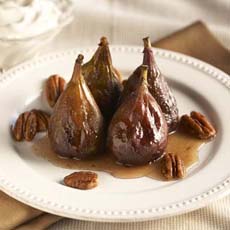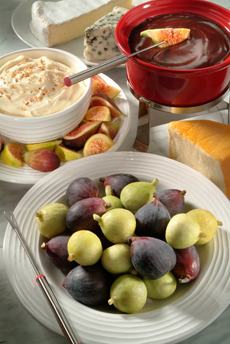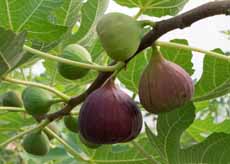TIP OF THE DAY: Have Some Figs For National Fig Week
 [1] Honey-roasted figs are a delicious dessert. You can serve them with goat cheese or mascarpone (photo courtesy Melissa’s).  Brown Turkey figs, a popular variety (photo courtesy Good Eggs).  [3] Fig fondue (photo courtesy California Figs). |
Figs are such a delicious fruit; but how often do you eat them? For inspiration, we have a delicious dessert recipe below.
The first week in November is a good excuse: It’s National Fig Week. > The history of figs is below. > A recipe for roasted figs with pecans and honey is also below—a simple yet elegant dessert. Buy whatever is plumpest and most visually appealing. Or, buy as many varieties as you can find, and have a comparison tasting. There are hundreds of varieties of figs in the world. In the U.S., commonly-found varieties include: |
|
|
THE HISTORY OF FIGS Wild figs, Ficus carica L., have grown in Africa, the Mediterranean, West Asia, and South Asia since about 100 million years ago, during the time of the dinosaurs. They are believed to have originated in south-central Asia (Asia Minor) and spread out from there. Many primates eat wild figs, and the first humans ate them as well. They discovered that figs could be dried and stored as winter staples. Around 11,000 years ago, people in West Asia had begun to cultivate fig trees. Farmed figs may be the first kind of food that anybody farmed, even before wheat and barley (the other contender for first-cultivated is dates). The fig tree is referenced repeatedly in both the Old and New Testaments; some scholars believe “the forbidden fruit” picked by Eve was a fig rather than an apple. Remains of fig trees have been found during excavations of Neolithic sites from 5000 B.C.E. Sumerian stone tablets dating back to 2500 B.C.E. record the culinary use of figs. Ancient Olympians were rewarded with figs, and Pliny the Elder extolled the fruit’s restorative powers. The prophet Mohammed [reportedly] identified the fig as the one fruit he would most wish to see in paradise [source]. Spanish Franciscan missionaries brought the fig to southern California in 1520, leading to the variety known as the Mission fig. Fig trees require hot climates to bear fruit, and can produce two crops every year. The leaves of the fig tree are also edible. The trees can live up to 100 years and can grow to 50 feet tall, though most cultivated trees are between 10 to 30 feet. In the U.S., the Bard Valley in southern California and the state of Texas produce most of the commercial crops. |
||
|
RECIPE: ROAST FIGS WITH PECANS & HONEY This variation of classic roasted figs was created by Chef Ida Rodriguez of Melissa’s Special Produce. Serve it with a glass of muscat or other dessert wine. 1. PREHEAT the oven to 400°F, setting a rack in the center. Coat a shallow baking dish with the butter and place figs in it, stem up. Sprinkle with 4 tablespoons of the sugar and add the wine. 2. BAKE in a preheated oven for 20 minutes, basting occasionally. 3. ADD the pecans and sprinkle with remaining tablespoon of sugar. Lower oven temperature to 300°F and bake 6 to 8 minutes longer. |
 [4] Figs on the tree (photo courtesy Indoor Citrus Trees).
|
|
|
4. TRANSFER the figs and pecans carefully to a serving dish. Add the honey to the cooking juices, and cook over low heat to blend. Spoon the syrup over figs and sprinkle with lemon juice and pepper. 5. SET aside to cool and then refrigerate. Serve cold with crème fraîche. CHECK OUT WHAT’S HAPPENING ON OUR HOME PAGE, THENIBBLE.COM.
|
||



